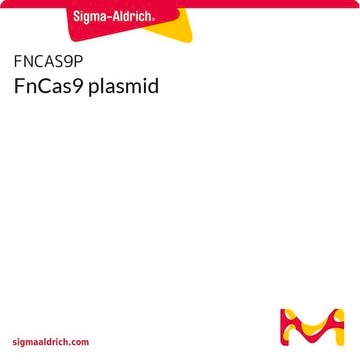CAS9P
Cas9 plasmid
About This Item
Produits recommandés
Produit recombinant
expressed in E. coli
Conditionnement
vial of 50 μL
Concentration
20 ng/μL in TE buffer; DNA (1μg of plasmid DNA)
Promoteur
Promoter name: CMV
selection
kanamycin
Conditions d'expédition
dry ice
Température de stockage
−20°C
Vous recherchez des produits similaires ? Visite Guide de comparaison des produits
Description générale
Application
- Creation of gene knockouts in multiple cell lines
- Complete knockout of genes not amenable to RNAi
- Creation of knock-in cell lines with promoters, fusion tags or reporters integrated into endogenous genes
Composants
Please note, product does not contain guideRNA sequence. This must be purchased separately through the Custom CRISPR product tab.
Principe
Forme physique
Notes préparatoires
Autres remarques
Typical transfection concentrations used in literature are in the ranges of >= 1.0 ug/uL and <= 5 uL of Cas9 plasmid combined with >= 1.0 ug/uL and <= 5 uL of U6-gRNA plasmids. (All dosages above assume 0.5 to 1 million cells nucleofected)
Informations légales
Code de la classe de stockage
10 - Combustible liquids
Point d'éclair (°F)
Not applicable
Point d'éclair (°C)
Not applicable
Certificats d'analyse (COA)
Recherchez un Certificats d'analyse (COA) en saisissant le numéro de lot du produit. Les numéros de lot figurent sur l'étiquette du produit après les mots "Lot" ou "Batch".
Déjà en possession de ce produit ?
Retrouvez la documentation relative aux produits que vous avez récemment achetés dans la Bibliothèque de documents.
Les clients ont également consulté
Protocoles
Learn about CRISPR Cas9, what it is and how it works. CRISPR is a new, affordable genome editing tool enabling access to genome editing for all.
Contenu apparenté
Sigma-Aldrich® Advanced Genomics is the leading provider of gene editing and silencing technologies including CRISPR, Cas9, synthetic guide RNA (sgRNA), and Zinc Finger Nuclease (ZFN).
Sigma-Aldrich® Advanced Genomics est le premier fournisseur de technologies d'édition et d'extinction géniques, dont CRISPR, Cas9, les ARN guides synthétiques (ARNsg) et les nucléases à doigts de zinc (ZFN pour "Zinc Finger Nucleases").
Notre équipe de scientifiques dispose d'une expérience dans tous les secteurs de la recherche, notamment en sciences de la vie, science des matériaux, synthèse chimique, chromatographie, analyse et dans de nombreux autres domaines..
Contacter notre Service technique

















